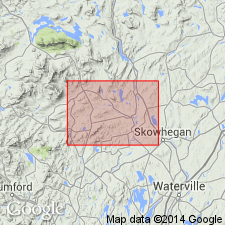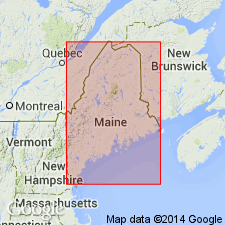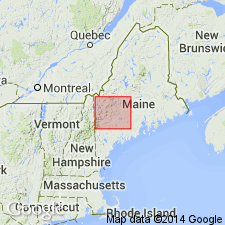
- Usage in publication:
-
- Day Mountain Member
- Modifications:
-
- Named
- Dominant lithology:
-
- Conglomerate
- Limestone
- Siltstone
- AAPG geologic province:
-
- New England province
Summary:
Day Mountain Member, uppermost of three members of the Seboomook Formation, is here named in west-central Maine. Replaces name Staples Pond Formation (of Warner and Pankiwskyj, 1965). Consists of rhythmically bedded gray metasiltstone, metapelite, and graywacke. Thickness exceeds 1,000 m. Divided into granule metaconglomerate and metalimestone submembers. Gradationally overlies and intertongues with Temple Stream Member. Age is Early Devonian.
Source: GNU records (USGS DDS-6; Reston GNULEX).

- Usage in publication:
-
- Day Mountain Formation
- Modifications:
-
- Revised
- AAPG geologic province:
-
- New England province
Summary:
Unit raised in rank to Day Mountain Formation of Seboomook Group and divided into 3 unnamed members: metaconglomerate, metasiltstone, and metapelite. Day Mountain is uppermost stratigraphic unit in west-central Maine. Seboomook also includes Northeast Carry (named), Ironbound Mountain (of Marvinney, in prep), Carrabassett, Temple Stream, Mount Blue, and Hildreths Formations.
Source: GNU records (USGS DDS-6; Reston GNULEX).

- Usage in publication:
-
- Day Mountain Member*
- Modifications:
-
- Revised
- AAPG geologic province:
-
- New England province
Summary:
Revised as upper member of Seboomook Formation. [Apparently follows usage of Pankiwskyj (1979) and not of Pollock (1987).] Composed of equal amounts of gray shale and quartzose lithic wacke. At least 1,000 m thick. Overlies gradationally and intertongues with Temple Stream Member of Seboomook Formation; overlying unit unknown because upper contact is not exposed. Rocks formerly called Staples Pond Formation (Pankiwskyj, 1979) are here called Day Mountain.
Source: GNU records (USGS DDS-6; Reston GNULEX).

- Usage in publication:
-
- Day Mountain Formation*
- Modifications:
-
- Revised
- Overview
- AAPG geologic province:
-
- New England province
Summary:
Day Mountain raised in rank to formation and assigned to Seboomook Group following usage of Pollock (1987). Occurs in central Maine trough in west-central ME. Consists of metasandstone, metasiltstone, and pelitic schist. Includes separately mapped lenses of granule conglomerate and impure limestone. Age is Early Devonian.
Source: GNU records (USGS DDS-6; Reston GNULEX).
For more information, please contact Nancy Stamm, Geologic Names Committee Secretary.
Asterisk (*) indicates published by U.S. Geological Survey authors.
"No current usage" (†) implies that a name has been abandoned or has fallen into disuse. Former usage and, if known, replacement name given in parentheses ( ).
Slash (/) indicates name conflicts with nomenclatural guidelines (CSN, 1933; ACSN, 1961, 1970; NACSN, 1983, 2005, 2021). May be explained within brackets ([ ]).

